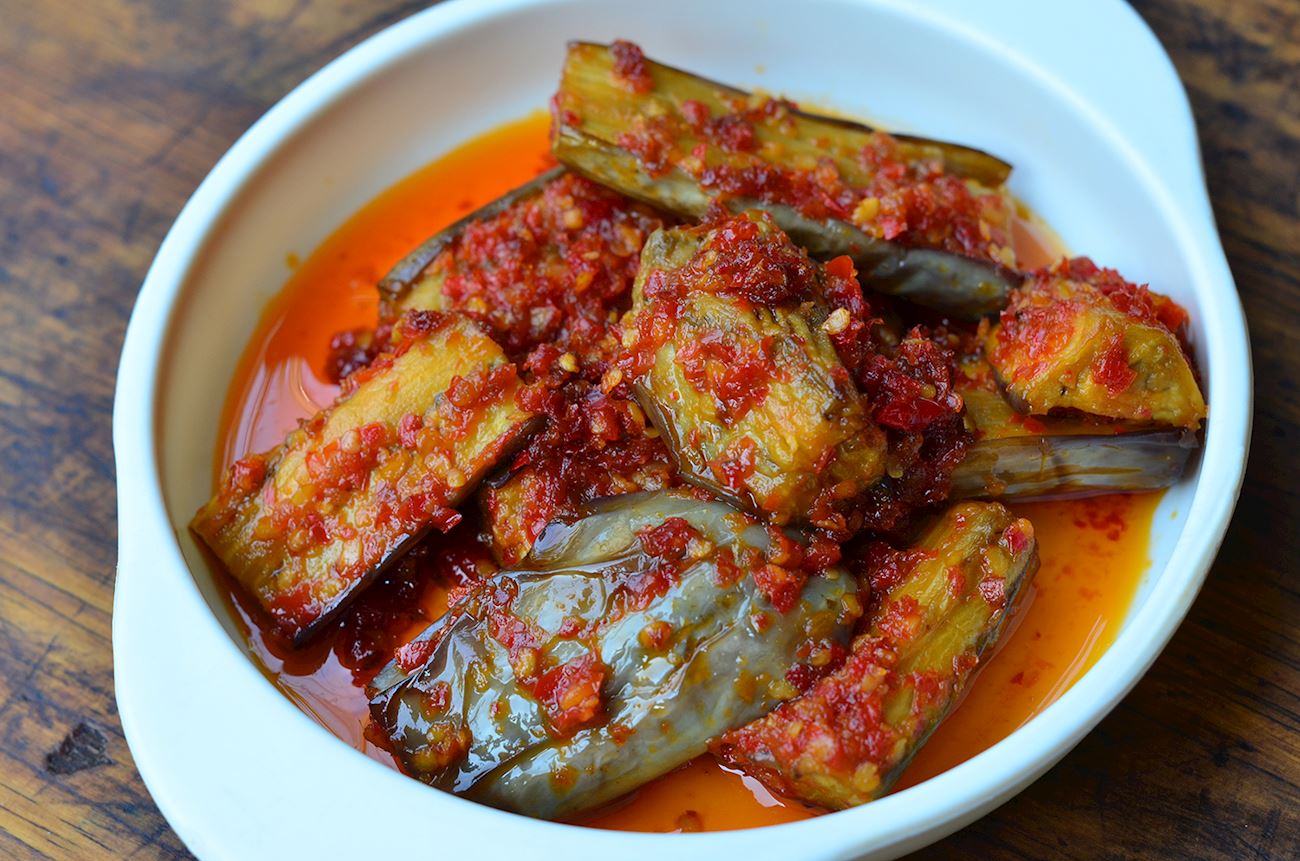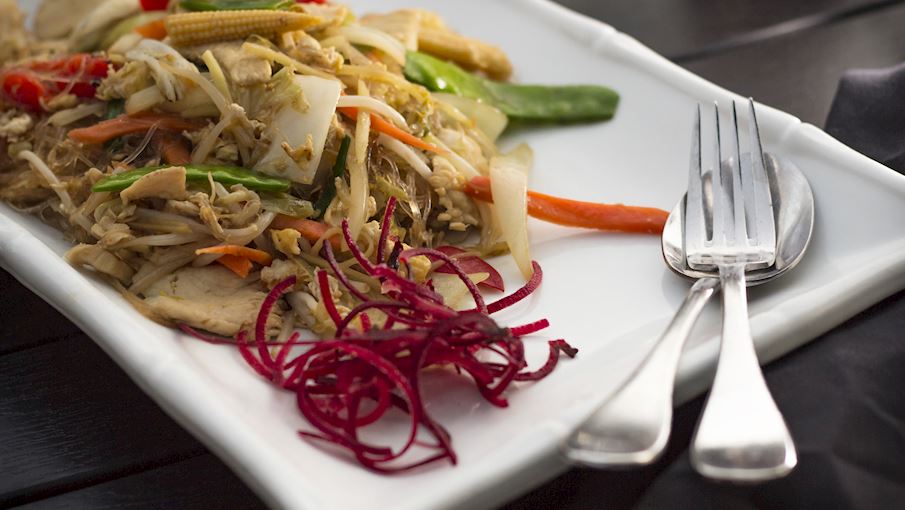MAIN INGREDIENTS
Pad woon sen is a traditional noodles dish. It consists of silky glass noodles that are stir-fried with vegetables such as carrots and cabbage, then topped with Thai bird chili and cilantro. The noodles should be soaked before the preparation. The sauce is made with water, soy sauce, oyster sauce, fish sauce, sugar, and white pepper.
Other common ingredients used in the dish include eggs, onions, garlic, bean sprouts, spring onions, and sometimes chicken, if desired. Before serving, it's recommended to garnish the dish with cilantro and sliced chili peppers.
Terong balado is a traditional dish that's suitable for vegetarians and vegans. It's made with a combination of eggplants and the spicy chili sauce known as balado. It's recommended to use Chinese eggplants as they are softer than standard eggplants.
The vegetables are cut into wedges, deep-fried, then stir-fried with the balado sauce. The sauce is made with a combination of red chili peppers, shallots, palm sugar, tamarind juice, garlic, and salt. When served, terong balado is usually accompanied by lots of white rice on the side.
Chai tow kway is a traditional dish originating from Chaoshan. The dish usually consists of radish cake (also known as turnip cake) that’s cut into cubes and stir-fried with eggs and seasonings. Radish cake is made with a combination of shredded daikon, rice flour, and water.
Chai tow kway can also be steamed and pan-fried, and the dish is typically garnished with scallions before serving. It’s also popular in countries such as Indonesia, Malaysia, and Singapore, where it’s a part of Teochew people cuisine.
In Singapore, the dish is also made in two versions – white (no soy sauce) and black (made with sweet soy sauce).
Nasi goreng USA is a traditional fried rice dish that's popular in Malaysia, Thailand, Singapore, and Indonesia. This variation of nasi goreng is distinguished by the additional ingredients accompanying fried rice such as chicken, squid, prawns, tomatoes, cucumbers, and sometimes fried eggs.
One of the basic nasi goreng USA versions is usually made with a combination of rice, oil, garlic, ginger, chicken, prawns, squid, sambal, hot peppers, onions, tomatoes, oyster sauce, soy sauce, white pepper, carrots, and cucumbers. The ingredients are sautéed and stir-fried to perfection, and the dish is then garnished with tomato and cucumber slices.
Nasi goreng nanas is a traditional variety of nasi goreng (fried rice). Although there are many recipes, the dish is usually made with a combination of rice, pineapple chunks, butter, garlic, shallots, scallions, carrots, prawns, peas, fish sauce, oyster sauce, curry powder, turmeric, oil, eggs, salt, and pepper.
Some ingredients are optional, such as prawns, peas, turmeric, and eggs, but they are often used to add more textures and flavors to the dish. The ingredients are sautéed in butter and stir-fried until everything is fully cooked. The dish is often served in hollowed-out pineapple bowls, especially in restaurants.
Nasi goreng kambing is a traditional nasi goreng (fried rice) variety originating from Malaysia, but it's also popular in Singapore and Indonesia. Although there are many versions, the dish is usually made with a combination of rice, minced mutton, carrots, shallots, garlic, cucumbers, ginger, chili peppers, oil, curry leaves, lime leaves, shrimp paste, fish sauce, coriander, cumin, cinnamon, turmeric, white vinegar, sugar, tomatoes, eggs, and salt.
The shallots, chili peppers, garlic, and shrimp paste are blended, fried in oil, and mixed with the herbs, salt, and fish sauce. The mutton and rice are then added to the pan and the dish is stir-fried for a few minutes before it's garnished with tomato slices and sometimes a fried egg.
MAIN INGREDIENTS
This southern Thai variety of dry curry combines spicy curry paste and ground pork. The fragrant paste consists of red chili peppers, lemongrass, garlic, turmeric, cilantro, galangal, and shrimp paste, while the whole dish is seasoned with palm sugar and fish sauce.
No liquid is added to the curry, allowing the pork to be thoroughly coated in the curry paste and producing an almost dry version of a stir-fry. The dish is usually served with fresh vegetables and rice on the side.
Udang balado is a traditional dish consisting of peeled or unpeeled shrimps that are stir-fried in a combination of cooking oil and spicy sambal sauce. The dish is often enriched with the addition of lemongrass, quail eggs, tofu, potatoes, or green beans.
As almost all balado dishes, this one is also very hot and fiery. When served, udang balado is often garnished with chopped scallions and accompanied by steamed rice. The dish is also known as sambal goreng udang.
Pancit is a staple Filipino dish found at numerous feasts and celebrations, consisting of stir-fried noodles with meat and vegetables such as chicken, pork, shrimp, celery, carrots, onions, garlic, and cabbage. The dish has Chinese origins, and the name of the dish is derived from the Hokkien phrase pian i sit, meaning something convenient, cooked fast.
Over time, pancit evolved and became a signature Filipino dish, so today, there are numerous variations of pancit such as pancit canton and pancit bihon. Egg noodles are used for pancit canton, while thin, translucent rice noodles are used for pancit bihon.
VARIATIONS OF Pancit
MOST ICONIC Pancit
View morePancit canton is a Filipino dish of Chinese origin which combines yellow wheat noodles and a variety of meat, seafood, and vegetables, blended with a flavorful mixture of soy and oyster sauce. The ingredients are easily adjusted to taste, availability, and preference and can be prepared separately or shortly stir-fried alongside noodles.
Since long and thick noodles symbolize long and prosperous life, this versatile and colorful dish is usually served on special occasions, such as various celebrations and birthday parties.
MOST ICONIC Pancit canton
View moreTasteAtlas food rankings are based on the ratings of the TasteAtlas audience, with a series of mechanisms that recognize real users and that ignore bot, nationalist or local patriotic ratings, and give additional value to the ratings of users that the system recognizes as knowledgeable. For the “11 Worst Rated Southeast Asian Stir-fry Dishes” list until January 30, 2025, 2,276 ratings were recorded, of which 1,747 were recognized by the system as legitimate. TasteAtlas Rankings should not be seen as the final global conclusion about food. Their purpose is to promote excellent local foods, instill pride in traditional dishes, and arouse curiosity about dishes you haven’t tried.













